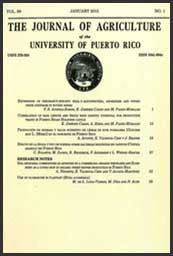Abstract
Fresh whole plant spring triticale (x Triticosecale spp.) was field wilted and chopped prior to either being sprayed or not with a homolactic bacterial inoculant (HBI). Wilted triticale was ensiled for 120 d at 20 to 23 °C using 16 PVC mini-silos of 3 L capacity fitted with two-way mechanics to vent gas (which imposed aerobic stress (ASTS) when it remained open), and filled with about 2 kg of the crop containing 35% dry matter (DM) and 5.2% water soluble carbohydrates (WSC) in the DM. Four treatments of a 2x2 factorial were: 1) No HBI/vent closed; 2) HBI/ vent closed; 3) No HBI/vent open; 4) HBI/vent open. Upon opening the mini-silos, chemical composition, fermentation characteristics and in vitro 30 h neutral detergent fiber (NDF) digestibility of the silages were determined. Relative to pre-ensiled forage, either sprayed or not with HBI, ensiling increased (P<0.05) contents of moisture, inorganic matter, fibrous fractions (acid detergent fiber (ADF) and lignin), and ether extract (EE), while decreasing contents of WSC and non-fibrous carbohydrates (NFC). However, treatment had no consistent effect on content of silage nutrients. Of the two non-inoculated silages, the one subjected to ASTS was more than 20 percentage points lower (66 vs. 88 %) in DM recovery (DMR), whereas the HBI silage subjected to ASTS was protected from DM losses. Ensiling and ASTS during the 120 d fermentation decreased NDF digestibility, whereas inoculated non-ASTS silage was nearly as digestible (57.5) as the pre-ensiled forages (58.2 and 60.7%, without and with HBI). Inoculation tended to steer fermentation in a homolactic direction. On balance, HBI is recommended because of the benefits in the fermentation pattern, fiber digestibility and DMR, especially in the presence of ASTS.Downloads
Download data is not yet available.

